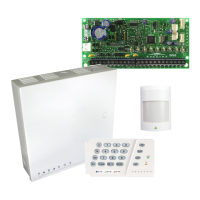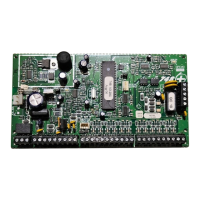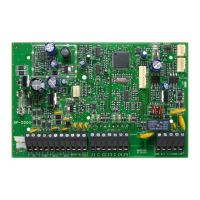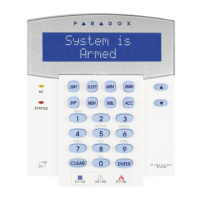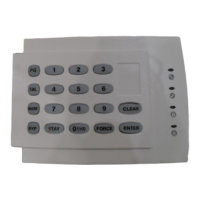EVOHD+ Installation Guide
49
Dialer Options
Telephone Line Monitoring
SECTION [3036]: OPTIONS [1] AND [2]
When enabled, the system verifies the existence of the main telephone line once every second. After each successful test, the Status LED on the control panel
flashes briefly. A line test failure occurs when the TLM detects less than 3 volts for the period defined by the TLM Fail Timer (see section ). If the line test fails, the
control panel will generate one or more conditions as defined by the TLM settings below, until it detects the telephone line again. When the dialer detects a
telephone ring, the TLM test stops for 1 minute.
TLM Fail Timer
SECTION [3053]
(default = 016) If the TLM does not detect the existence of the main telephone line for the time programmed in this section, the control panel will generate the
condition(s) defined by the TLM options (see section ). Enter any value between 016 and 255 (value is X2 seconds) into section
[3053]. Entering a value between 000
and 016 will set the TLM Fail Timer to 32 seconds.
Tone/Pulse Dialing
SECTION [3036]: OPTION [4]
(default = enabled)
Pulse Ratio
SECTION [3036]: OPTION [5]
(default = enabled) When using Pulse dialing (see section ), select one of two Pulse Ratios. If the selected pulse ratio does not provide adequate results, try the other
one.
Busy Tone Detection
SECTION [3036]: OPTION [6]
(default = enabled) When enabled, the control panel immediately hangs up if it receives a busy signal when it dials an outside number.
Switch To Pulse
SECTION [3036]: OPTION [7]
(default = disabled) When
is enabled, the control panel switches from tone dialing to pulse dialing on the fifth attempt to report events to the monitoring station.
The control panel continues to use pulse dialing until it establishes communication. When the control panel switches to another monitoring station telephone
number, it returns to tone dialing and switches back to pulse dialing on the fifth attempt.
Bell On Communication Fail
SECTION [3036]: OPTION [8]
(default = disabled) When enabled and the control panel fails to communicate with the monitoring station when the partition is armed, the control panel can
enable the BELL output.
Keypad Beep on Successful Arm or Disarm Report
SECTION [3037]: OPTION [5]
(default = disabled) When enabled and a user arms or disarms a partition, the keypad emits a beep tone to confirm that the monitoring station received the arming
or disarming report code.
Dial Tone Delay
SECTION [3037]: OPTION [7]
(default = disabled)
If more time is required, insert a 4-second pause into the desired telephone number sequence.
[1] [2] Feature When the line test fails
OFF OFF
Disabled TLM disabled (default).
ON OFF
Trouble Only
The Communicator trouble appears in the Trouble
Display.
OFF ON
Alarm when Armed
The Communicator trouble appears in the Trouble
Display. If the partition is armed, the control panel
generates an alarm.
ON ON
Silent Alarms
become Audible
The Communicator trouble appears in the Trouble
Display. The control panel switches any triggered Silent
Alarm zones or Silent panic alarms to an audible alarm.
[4]
ON
Tone/DTMF format
[4]
OFF
Pulse dialing format
[5]
ON
North American pulse ratio of 1:1.5
[5]
OFF
European pulse ratio of 1:2
[7]
ON
If no dial tone is present, dialer hangs up after 32 secs.
[7]
OFF
If no dial tone is present, force dials after 3 secs.
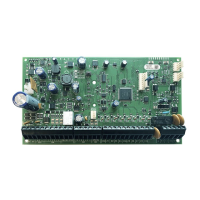
